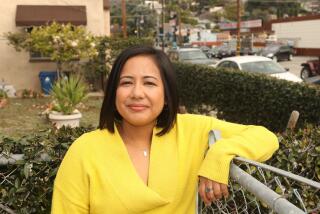Youths Help Themselves by Helping Others : Leadership: A group of 60 East L.A. teen-agers strive to stay in school and out of trouble while working to better their community. The grass-roots effort, run by the members themselves, has found success.
They want to make positive changes in their community. They want to make positive changes in themselves. And they want to do it on their own terms.
Calling themselves the East Los Angeles Youth Leadership Council, 60 teen-agers have decided they want to stay in school and out of trouble and at the same time work toward bettering their neighborhood. And despite their constant struggle for funding, they have been successful where much larger, highly publicized efforts have failed.
“The reason a lot of us are here is because this is our group. No one tells us what to do,” said Michelle Prado, 17. “I’m here because I feel it’s my obligation to help my community because I live here. This is not just about having fun but also actually doing things for others,” she added, echoing the sentiments of many of the 30 or so youths who gathered for their weekly meeting at Our Lady of Lourdes Church in East Los Angeles.
Turning the youth council into a grass-roots effort was Guy Torres’ main concern when he rounded up 15 neighborhood youths and founded the group in March, 1994.
Torres was working at the time with Hope in Youth, the county-funded anti-gang program, which has since moved out of an unincorporated area of East Los Angeles because of severe budget cuts.
“The youth were a little bit frustrated with Hope in Youth because they ultimately didn’t have a say in what went on, and they really weren’t getting anything from the organization,” said Torres, whose official title is program director and who has worked with young people for the past seven years.
Although the council does not describe itself as an anti-gang program, it clearly provides an alternative at a time of increasing interest from community members and government and religious leaders in fostering such groups.
Under Torres’ guidance, the ever-growing council has, among other things, painted murals, initiated a peer mentoring program at Garfield High School, taken over the cleanup of two miles of East Los Angeles streets as part of the Adopt-a-Highway Program, provided leadership seminars and employment training for youths, and organized a myriad activities for members and the community at large.
*
The group raises its own money through events such as parties and carwashes. It is also applying for grants from various organizations. And in what the group considers a major coup, Los Angeles County Supervisor Gloria Molina recently provided it with $62,847 from her discretionary funds.
Molina’s action is considered significant in that she voted against funding for Hope in Youth this fiscal year.
“The program we’ve developed through the Leadership Council is much more doable,” said Molina’s press deputy, Michael Bustamante. “There is a strong commitment from the youth in the community to try to make a difference with their peers and with others. . . . We’re hoping to see direct intervention, parenting programs, and to make sure kids stay in school.”
Staying in school seems to be a high priority for many of the youngsters who attend council meetings. On a recent Wednesday, the first item on the agenda was a leadership seminar conducted by Torres, who started by handing over a dictionary to Judee Fernandez, 17.
“Lead,” read Fernandez in a clear, confident voice. “To go ahead, to show the way.”
Like many of those at the meeting, Fernandez sees herself as a leader and plans to go to college upon graduating from Garfield High.
“I want to study international relations or communications and here I can practice public speaking and get leadership skills,” she said. “A lot of the kids that come here, they have problems, but they can’t speak with adults. . . . When we’re here it helps us communicate.”
For some, the council does much more than just help communicate. Miguel, 18, currently on probation for grand theft auto and assault with a deadly weapon, has stayed out of trouble since he joined the group a year ago.
*
“The first time I liked it so-so, but when I kept going I started liking it,” he said. “And right now I’m looking for a job and I want to get my G.E.D. in East L.A. College and hopefully major in something. If I wasn’t in the group I’d still be a troublemaker.”
Membership in the group is significant even for those youths who have not been in serious trouble.
“What people need to know is that we’re not a statistic,” said John Saldana, 17. “A lot of us are graduating from high school and a lot of our parents didn’t. My mother didn’t even finish junior high and all my uncles thought I’d drop out of high school. But I didn’t,” he said proudly.
Like many of the youths here, Saldana comes from a single-parent family. The group, they say, provides them with added support when what they get at home is not enough.
“This is the kind of group East L.A. needs,” says Rafael Narvaez, 17. “It helps kids make something of themselves, especially if both parents work. It’s like a surrogate mother or father, in a way.”
Unlike many youth programs, the council was founded and is run by the youths themselves, without any outside or adult intervention. When members turn 18, for example, they lose their right to vote, although they can continue their affiliation as peer advisers.
*
“They are unusual in that they started themselves and they are much more than a social group,” said Father Richard Siebenand from Our Lady of Lourdes. “A group like this gives youths another alternative to gang life. It’s given the youths more self-esteem and it tries to establish communication between the youths and their families. I know the parents of the kids in the group are very much for it.”
For founder Torres--who at 27 cannot vote in meetings--the effects of the council are even more far-reaching.
“I work with youth because I struggled in my adolescence with running the street, truancy and being from a single-parent family. I know the need these kids have for someone to give them direction and help them develop their skills. . . . They have so little resources and there’s a lot that they need and a lot that they want to do. But I want them to learn not only their rights but also their responsibilities.”
For Claudia Silva, at 14 one of the youngest in the group, responsibilities are clear: “You help your community when you come to the meetings. You keep kids out of trouble, you clean the streets, you interact with other people of different ages. And it’s more fun.”
More to Read
Sign up for Essential California
The most important California stories and recommendations in your inbox every morning.
You may occasionally receive promotional content from the Los Angeles Times.










